Study on the Method of Matched Splice Grafting for Melon Seedlings Based on Visual Image
Abstract
:1. Introduction
2. Materials and Methods
2.1. Matched Grafting Method
2.1.1. Grafting Method
2.1.2. Matching Model
2.2. Visual Image Analysis System
2.2.1. Structure of the System
2.2.2. Characteristic Identification and Extraction
- Gray processing
- 2.
- Threshold segmentation
- 3.
- Feature measurement
2.3. Test Method
2.3.1. Test Materials
2.3.2. Morphological Parameters of Seedlings
2.3.3. Cutting Model of the Rootstock Seedling
3. Results and Discussion
4. Conclusions
- (1)
- Based on the existing grafting machine, the operating parameters of the cutting mechanism need to be adjusted by manual experience, and the cutting angle of the seedlings cannot be obtained, resulting in problems such as the low fitting accuracy of the grafted seedlings and low survival rate. In this paper, a visual image-based grafting method for melons was proposed. The visual system was used to obtain the structure of the pith cavity and morphological information of the rootstock, and the grafting model of the rootstock and the scion were constructed to realize the standardized and precise cutting operation of them.
- (2)
- In order to obtain the geometric model of the cutting area of the rootstock, a visual image analysis system was established to identify, analyze, and model the pith cavity structure inside the rootstock seedlings and morphological characteristics, and the ultimate cutting angle of the rootstock seedlings and cutting surface parameters were determined. By measuring the length of the short axis of scion seedlings to achieve the optimal fitting of them, the optimal cutting angle of the rootstocks and scion seedlings was determined, and then grafting and seedling cultivation tests were carried out.
- (3)
- The test results showed that the cutting angle on rootstock seedlings was 18.21 ± 1.92°, and the matching cutting angles of the rootstock and scion seedlings were 22° and 19.68°, respectively. The cutting surface length was 4.96 mm, and cutting surface thickness of the rootstock was 0.13mm, which could satisfy the technological requirements in splice grafting of melons. The research results realized the concept of maximizing the cutting surfaces of the rootstock and the scion, which can be applied to the technology development, optimization, and upgrading of the cutting mechanism of the grafting machine.
5. Patents
Author Contributions
Funding
Institutional Review Board Statement
Informed Consent Statement
Data Availability Statement
Conflicts of Interest
References
- Guan, W.J.; Zhao, X.; Hassell, R.; Thies, J. Defense mechanisms involved in disease resistance of grafted vegetables. Horticulture 2012, 47, 164–170. [Google Scholar] [CrossRef] [Green Version]
- Turhan, A.; Ozmen, N.; Kuscu, H.; Serbeci, M.S.; Seniz, V. Influence of rootstocks on yield and fruit characteristics and quality of watermelon. Hortic. Environ. Biotechnol. 2012, 53, 36–341. [Google Scholar] [CrossRef]
- Bantis, F.; Koukounaras, A.; Siomos, A.S.; Dangitsis, C. Impact of scion and rootstock seedling quality selection on the vigor of watermelon–interspecific squash grafted seedlings. Agriculture 2020, 10, 326. [Google Scholar] [CrossRef]
- Liu, C.J.; Lin, W.G.; Feng, C.R.; Wu, X.S.; Fu, X.H.; Xiong, M.; Bie, Z.L.; Huang, Y. A new grafting method for watermelon to inhibit rootstock regrowth and enhance scion growth. Agriculture 2021, 11, 812. [Google Scholar] [CrossRef]
- Cohen, R.; Burger, Y.; Horev, C.; Koren, A. Introducing grafted cucurbits to modern agriculture: The Israeli experience. Plant Dis. 2007, 91, 916–923. [Google Scholar] [CrossRef] [Green Version]
- Zhu, C.Y.; Yue, D.J. Production status and technology trend of vegetable seedling industry in China. Agric. Eng. Technol. 2019, 39, 34–38. [Google Scholar]
- Liu, M.C.; Ji, Y.H.; Wu, Z.H.; He, W.M. Current situation and development trend of vegetable seedling industry in China. China Veg. 2018, 11, 1–7. [Google Scholar]
- Wang, L. Current situation and development of factory seedling production in China. Agric. Eng. Technol. 2017, 37, 15–19. [Google Scholar]
- Huang, Y.; Kong, Q.S.; Chen, F.; Bie, Z.L. The History, current status and future prospects of vegetable grafting in China. Acta Hortic. 2015, 1086, 31–39. [Google Scholar] [CrossRef]
- Lewis, M.; Kubota, C.; Tronstad, R.; Son, Y.-J. Scenario-based cost analysis for vegetable grafting nurseries of different technologies and sizes. HortScience 2014, 49, 917–930. [Google Scholar] [CrossRef]
- Devi, P.; Lukas, S.; Miles, C. Advances in watermelon grafting to increase efficiency and automation. Horticulturae 2020, 6, 88. [Google Scholar] [CrossRef]
- Zhao, C.J. Current situations and prospects of smart agriculture. J. South China Agric. Univ. 2021, 42, 1–7. [Google Scholar]
- Yang, R.; Wang, Y.K.; Wang, B.K. Progress and trend of agricultural robots based on WoS bibliometrics and knowledge graph. Trans. Chin. Soc. Agric. Eng. 2022, 38, 53–62. [Google Scholar]
- Wang, R.J.; Sun, B.Y. Development status and expectation of agricultural robot. Bull. Chin. Acad. Sci. 2015, 30, 803–809. [Google Scholar]
- Zhang, K.L.; Chu, J.; Zhang, T.Z.; Yin, Q.; Kong, Y.S.; Liu, Z. Development status and analysis of automatic grafting technology for vegetables. Trans. Chin. Soc. Agric. Mach. 2017, 48, 1–13. [Google Scholar]
- Comba, L.; Gay, P.; Aimonino, D.R. Robot ensembles for grafting herbaceous crops. Biosyst. Eng. 2016, 146, 227–239. [Google Scholar] [CrossRef]
- ISO Group. Available online: http://www.iso-group.nl (accessed on 14 March 2022).
- Conic System. Available online: http://www.conic-system.com (accessed on 14 March 2022).
- Pardo-Alonso, J.L.; Carreño-Ortega, Á.; Martínez-Gaitán, C.C.; Fatnassi, H. Behavior of different grafting strategies using automated technology for splice grafting technique. Appl. Sci. 2020, 10, 2745. [Google Scholar] [CrossRef]
- Xie, Z.J.; Gu, S.; Chu, Q.; Li, B.; Fan, K.J.; Yang, Y.L.; Yang, Y.; Liu, X.G. Development of a high-productivity grafting robot for Solanaceae. Int. J. Agric. Biol. Eng. 2020, 13, 82–90. [Google Scholar] [CrossRef]
- Kubota, C. Cultivation of grafted vegetables ii. development of grafting robots in Japan. HortScience 1994, 29, 240–244. [Google Scholar]
- Kobayashi, K.; Sasaya, S. Study on automation of seedlings feeding for grafting robot for cucurbitaceous vegetables (Part 2). Agric. Mach. Food Eng. 2007, 69, 70–77. [Google Scholar]
- Ohkoshi, T.; Kobayashi, K. Development of automatic seedling feeding device for cucurbits grafting robot (Part 1)—Evaluation of automatic stock feeder. J. Jpn. Soc. Agric. Mach. Food Eng. 2013, 75, 100–107. [Google Scholar]
- Kang, D.H.; Lee, S.Y.; Kim, J.K.; Park, M.J.; Son, J.K.; Yun, S.W. Development of an automatic grafting robot for fruit vegetables using image recognition. Prot. Hortic. Plant Fact. 2019, 28, 322–327. [Google Scholar] [CrossRef]
- Kim, H.M.; Hwang, S.J. Comparison of pepper grafting efficiency by grafting robot. Prot. Hortic. Plant Fact. 2015, 24, 57–62. [Google Scholar] [CrossRef]
- Jiang, K. Study on Mechanism and Experimental Device of Splice Mechanical Grafting of Cucurbit. Ph.D. Thesis, Northeast Agricultural University, Harbin, China, 2019. [Google Scholar]
- Gu, S. Development of 2JC-350 automatic grafting machine with cut grafting method for vegetable seedling. Trans. Chin. Soc. Agric. Eng. 2006, 22, 103–106. [Google Scholar]
- Chu, Q.; Jiang, K.; Liu, K.; Gu, S. Experimental study on 2JC-600 automatic grafting machine. J. Agric. Mech. Res. 2011, 33, 83–85. [Google Scholar]
- Yang, Y.L.; Li, K.; Chu, Q.; Zhong, L.X.; Jia, D.D.; Gu, S. Air suction clamp structure of rootstock cotyledons for inclined inserted grafting machine and its optimized experiment of operation parameters. Chin. Soc. Agric. Eng. 2014, 30, 25–31. [Google Scholar]
- Lou, J.Z.; Wu, K.; Chen, J.Y.; Ma, G.Y.; Li, J.P. Design and test of self-adaptive stock cotyledons pressing and clamping mechanism for oblique inserted grafting of Cucurbitaceous vegetables. Chin. Soc. Agric. Eng. 2018, 34, 76–82. [Google Scholar]
- Wu, K.; Lou, J.; Li, C.; Li, J. Experimental evaluation of rootstock clamping device for inclined inserted grafting of melons. Agriculture 2021, 11, 736. [Google Scholar] [CrossRef]
- Tong, J.H.; Yu, Q.C.; Pan, J.H.; Yang, T.W.; Ding, Y.H. Design and experiment of automatic carrying and replanting device for both-root-cut grafting machine. Trans. Chin. Soc. Agric. Mach. 2017, 48, 59–66. [Google Scholar]
- Tong, J.H.; Ding, Y.H.; Wu, C.Y.; Yu, Q.C.; Pan, J.H.; Sun, L. Design and experiment of key mechanism for semi-automatic vegetable grafting machine. Trans. Chin. Soc. Agric. Mach. 2018, 49, 65–72. [Google Scholar]
- Jiang, K.; Zheng, W.G.; Zhang, Q.; Guo, R.; Feng, Q.C. Development and experiment of vegetable grafting robot. Chin. Soc. Agric. Eng. 2012, 28, 8–14. [Google Scholar]
- Jiang, K.; Guo, W.; Chen, L.; Huang, W.; Ge, Y.; Wei, X. Design and experiment of automatic clip-feeding mechanism for vegetable-grafting robot. Agriculture 2022, 12, 346. [Google Scholar] [CrossRef]
- Jiang, K.; Zhang, Q.; Chen, L.P.; Guo, W.Z.; Zheng, W.G. Design and optimization on rootstock cutting mechanism of grafting robot for cucurbit. Int. J. Agric. Biol. Eng. 2020, 13, 117–124. [Google Scholar] [CrossRef]
- Chen, L.P.; Jiang, K.; Zhang, Q.; Guo, W.Z.; Zheng, W.G. Design and experiment on scion cutting mechanism of grafting robot for cucurbit. Int. J. Agric. Biol. Eng. 2020, 13, 99–106. [Google Scholar] [CrossRef]
- He, L.Y.; Cai, L.Y.; Wu, C.Y. Vision-based parameters extraction of seedlings for grafting robot. Chin. Soc. Agric. Eng. 2013, 29, 190–195. [Google Scholar]
- Cui, Y.J.; Wang, X.X.; Xu, L.Q.; Chen, T.; Li, S.H.; Fu, L.S. Automatic detection for external features of grafting seedlings based on machine vision. Trans. Chin. Soc. Agric. Mach. 2014, 45, 89–95. [Google Scholar]
- Shang, Q.M.; Wang, X.B.; Zhang, W.L. Technical specification for intensive grafting seedling raising of melon vegetables. China Veg. 2022, 6, 108–114. [Google Scholar]
- Wu, W.H.; Wang, P.; Tong, L.H.; Zhou, M.B.; Ding, M.; Peng, J.G. Research progress of grafting and seeding technology on melon vegetables in China. J. Chang. Veg. 2012, 6, 14–16. [Google Scholar]
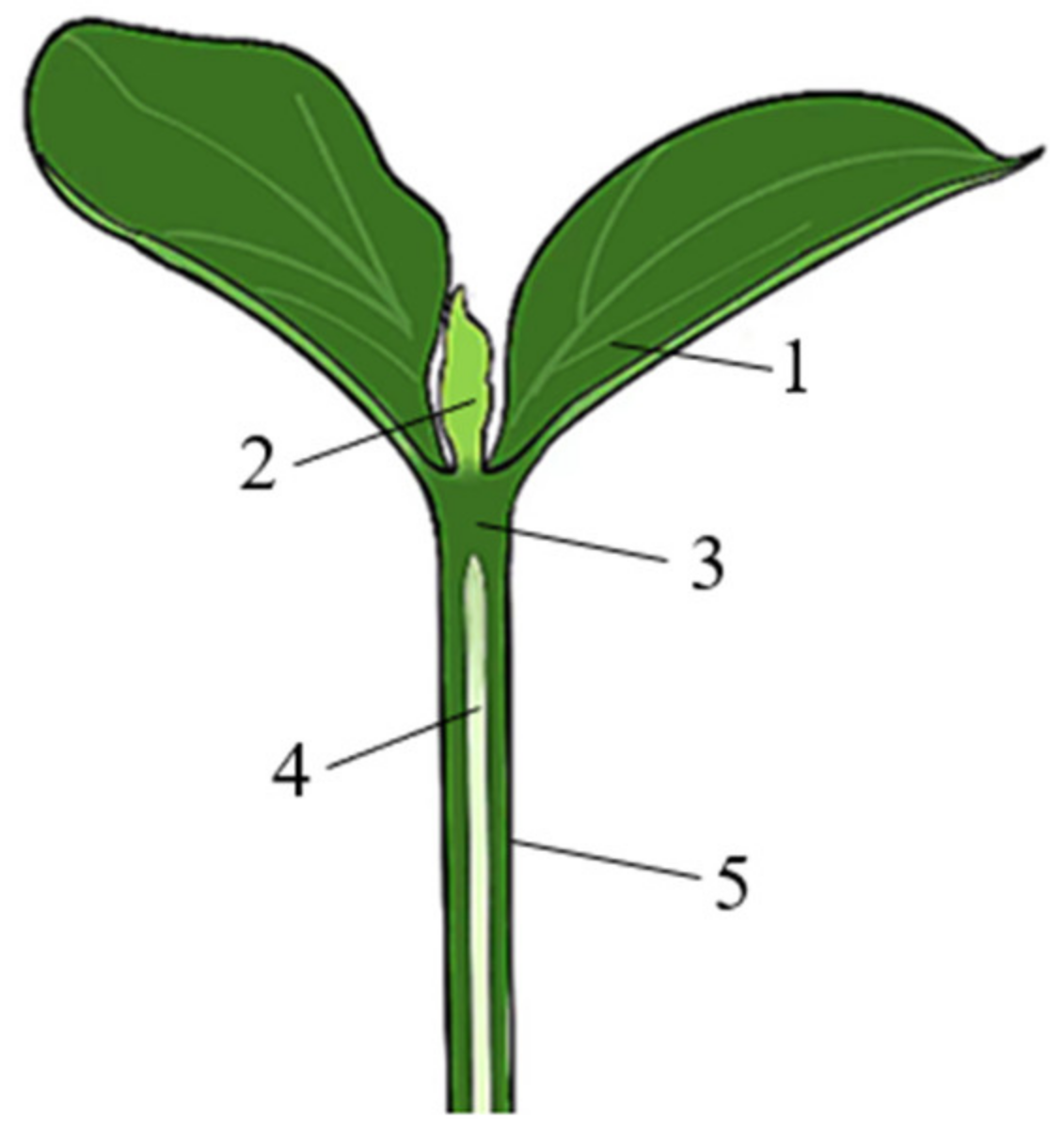
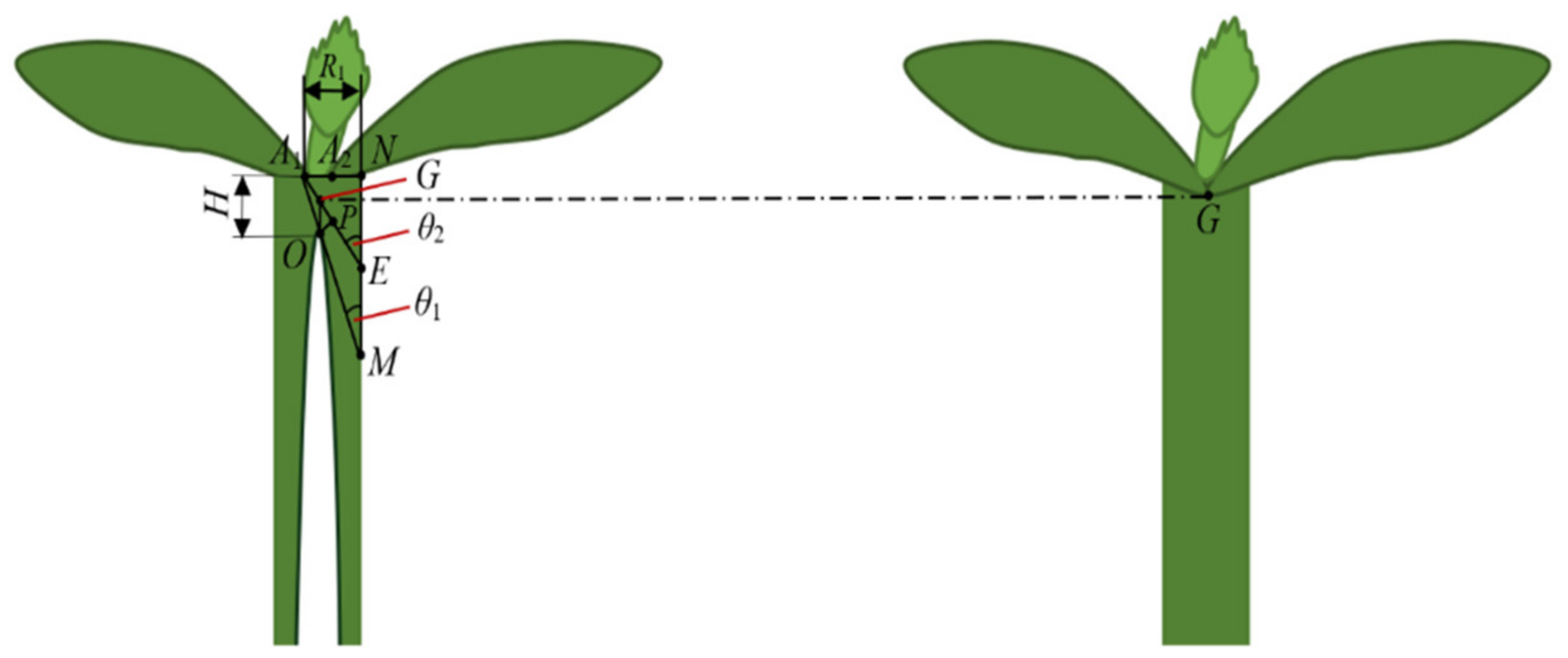

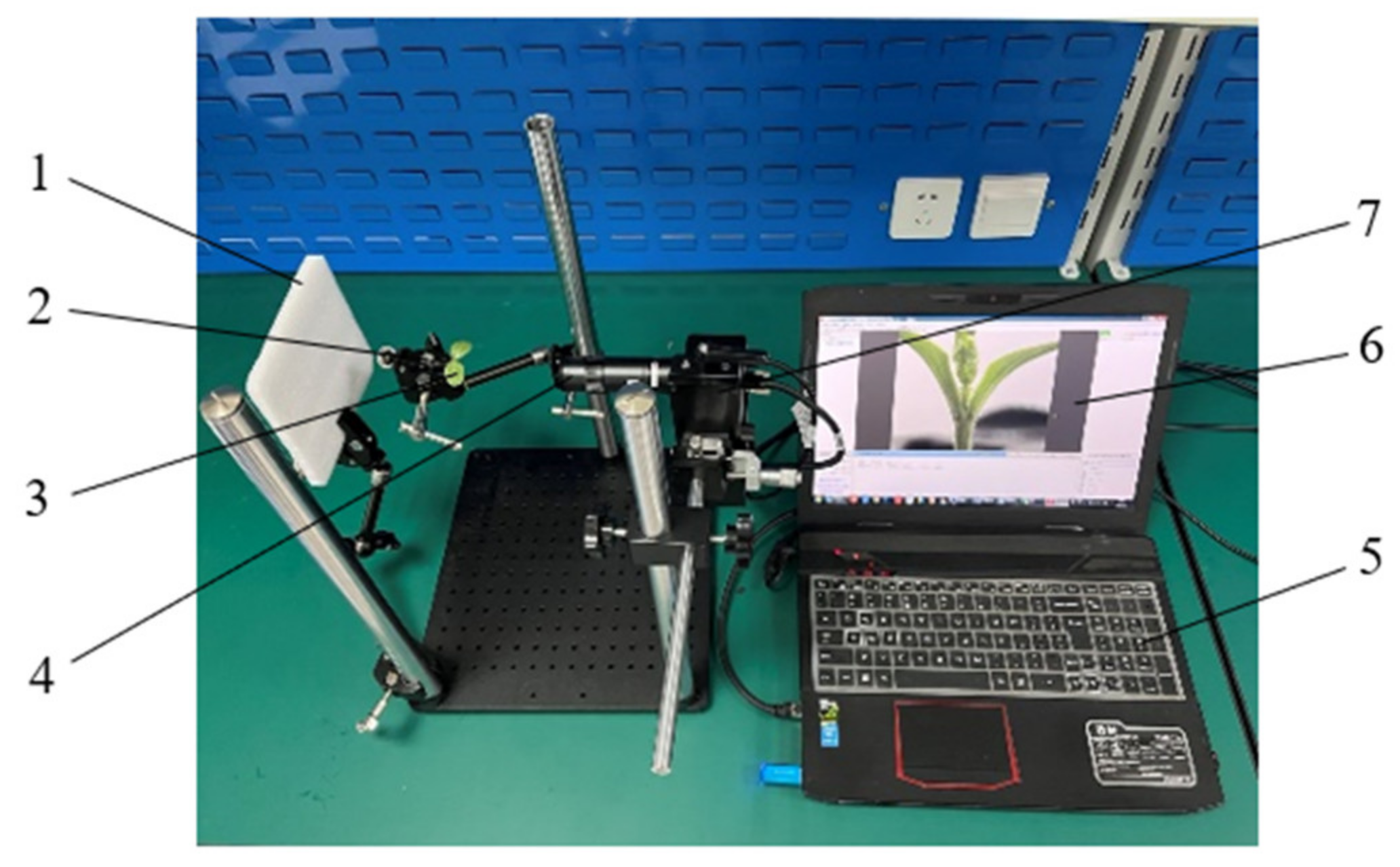
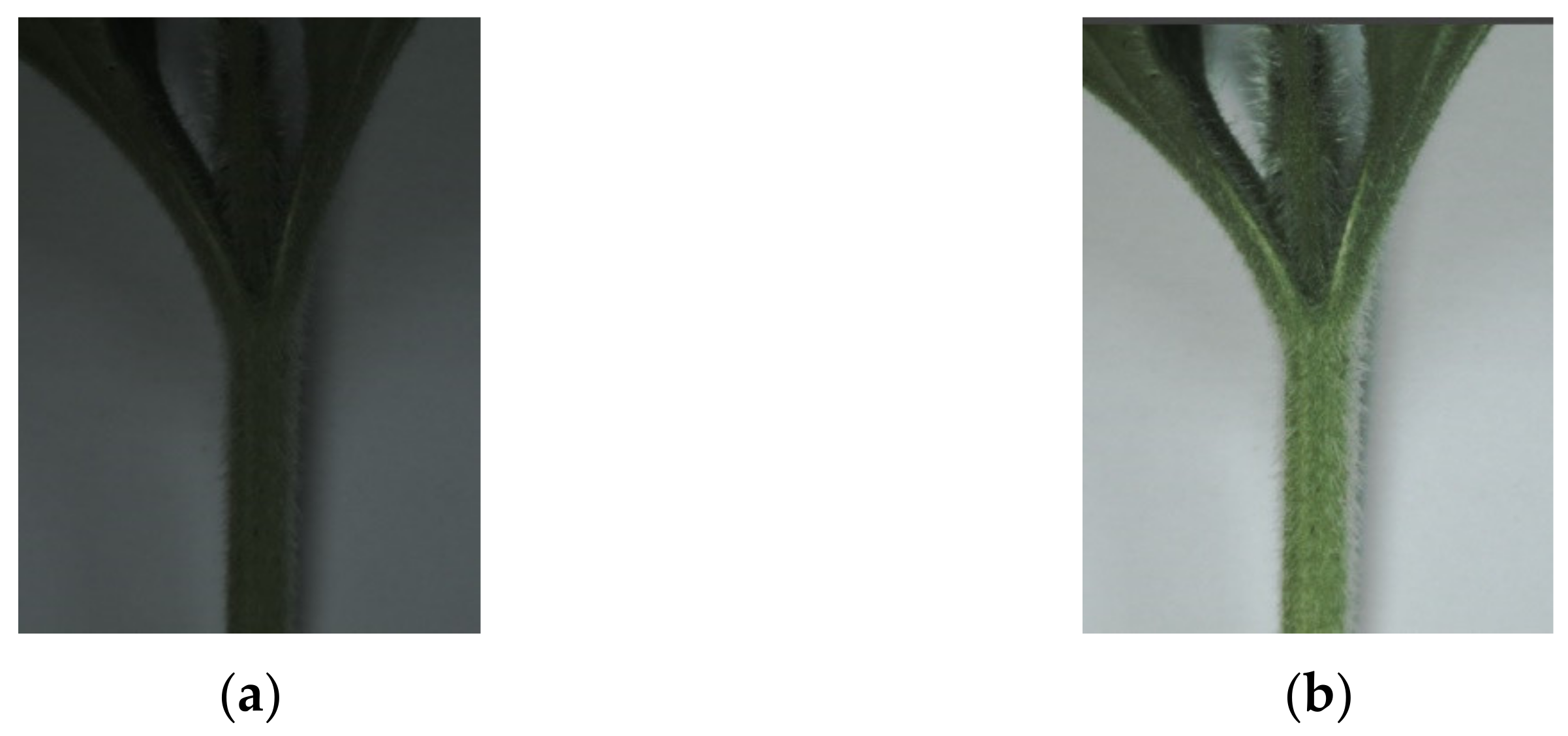



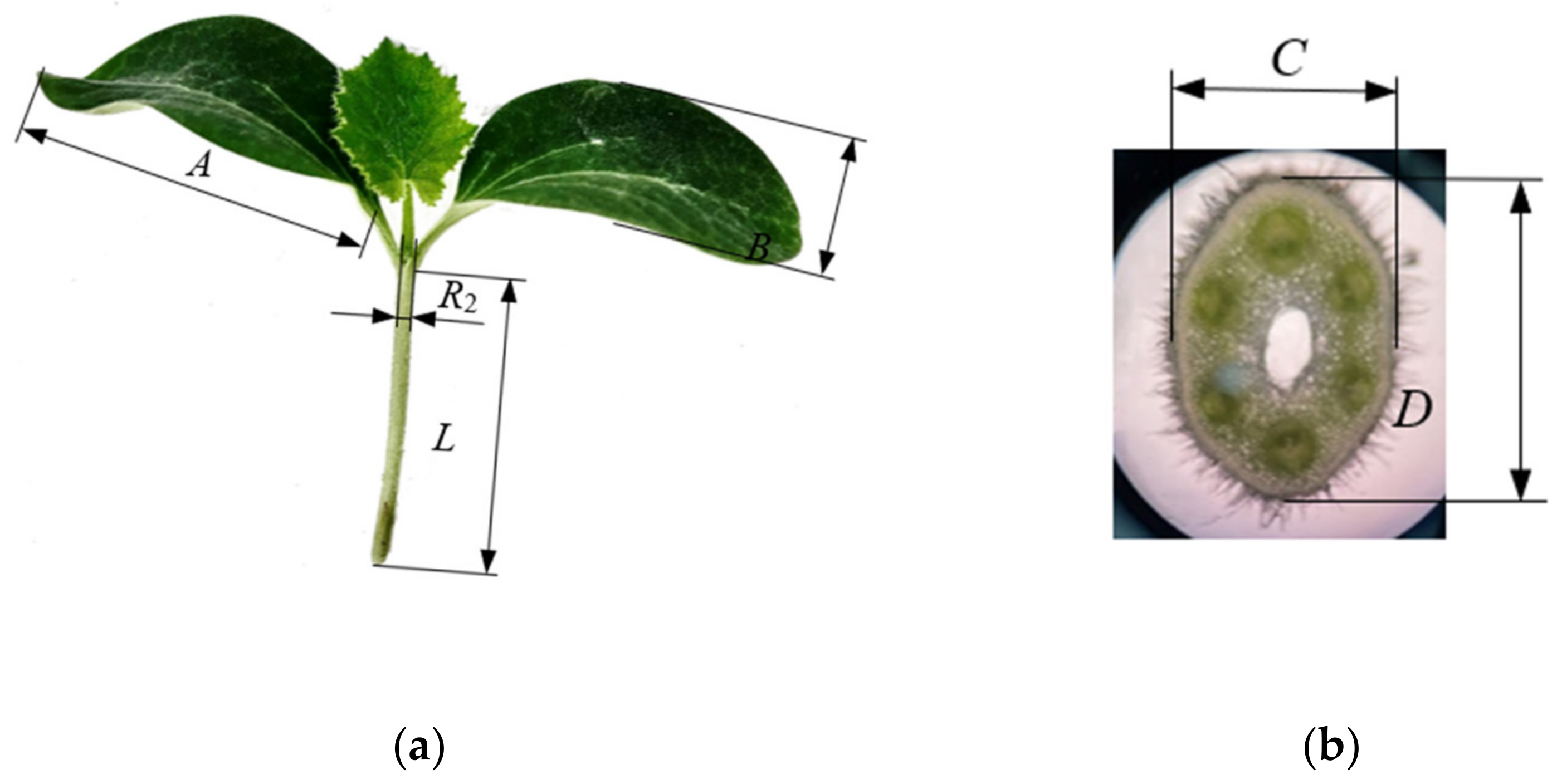


| Object | Seedling Height L (mm) | Seedling Stem Long Axis D (mm) | Seedling Stem Short Axis C (mm) | Length–Width Ratio of Seedling Stem ζ | Cotyledon Length A (mm) | Cotyledon Width B (mm) | Growing Point Width R2 (mm) |
|---|---|---|---|---|---|---|---|
| Rootstock seedling | 43.57 ± 2.65 (CV 6.08%) | 2.41 ± 0.18 (CV 7.46%) | 2.23 ± 0.16 (CV 7.17%) | 1.08 | 37.60 ± 3.14 (CV 8.35%) | 25.44 ± 2.56 (CV 10.06%) | 1.21 ± 0.10 (CV 8.26%) |
| Scion seedling | 34.42 ± 3.21 (CV 9.33%) | 2.34 ± 0.19 (CV 8.12%) | 1.66 ± 0.13 (CV 7.83%) | 1.41 | 22.79 ± 2.84 (CV 12.46%) | 16.76 ± 0.88 (CV 5.25%) | - |
| Object | Left Base Point of Growing Point to the Right Edge of Seedling Stem, R1 (mm) | Width of the Growing Point, R2 (mm) | Stem Height, H (mm) | Distance from Pith Cavity Vertex to the Point of Intersection of Cotyledons, LOG (mm) |
|---|---|---|---|---|
| Rootstock seedling | 1.88 ± 0.15 (CV 7.97%) | 1.21 ± 0.10 (CV 8.26%) | 1.84 ± 0.12 (CV 6.52%) | 0.79 ± 0.16 (CV 20.22%) |
| Object | Parameters | Values |
|---|---|---|
| Rootstock seedling | The ultimate cutting angle, θ1 (°) | 18.21 ± 1.92 |
| (mm) | 6.00 ± 0.76 | |
| The cutting angle through point G, θ2 (°) | 28.32 ± 2.56 | |
| (mm) | 3.95 ± 0.65 | |
| (mm) | 0.31 ± 0.08 | |
| Scion seedling | Cutting angle, α (°) | 24.71 ± 2.83 |
| Cutting Angle of the Rootstock (°) | Length of Cutting Surface Length (mm) | Thickness of Cutting Surface Length (mm) | Cutting Angle by Matching Rootstock and Scion (°) | Vertical Height of the Cutting Surface of the Scion (mm) |
|---|---|---|---|---|
| 20 | 5.43 ± 0.44 | 0.06 ± 0.01 | 17.91 | 5.17 ± 0.47 |
| 22 | 4.96 ± 0.40 | 0.13 ± 0.02 | 19.68 | 5.12 ± 0.48 |
| 24 | 4.57 ± 0.37 | 0.20 ± 0.01 | 21.45 | 5.06 ± 0.48 |
| 26 | 4.24 ± 0.35 | 0.27 ± 0.02 | 23.22 | 4.99 ± 0.49 |
Publisher’s Note: MDPI stays neutral with regard to jurisdictional claims in published maps and institutional affiliations. |
© 2022 by the authors. Licensee MDPI, Basel, Switzerland. This article is an open access article distributed under the terms and conditions of the Creative Commons Attribution (CC BY) license (https://creativecommons.org/licenses/by/4.0/).
Share and Cite
Xu, P.; Zhang, T.; Chen, L.; Huang, W.; Jiang, K. Study on the Method of Matched Splice Grafting for Melon Seedlings Based on Visual Image. Agriculture 2022, 12, 929. https://doi.org/10.3390/agriculture12070929
Xu P, Zhang T, Chen L, Huang W, Jiang K. Study on the Method of Matched Splice Grafting for Melon Seedlings Based on Visual Image. Agriculture. 2022; 12(7):929. https://doi.org/10.3390/agriculture12070929
Chicago/Turabian StyleXu, Pengyun, Tong Zhang, Liping Chen, Wenqian Huang, and Kai Jiang. 2022. "Study on the Method of Matched Splice Grafting for Melon Seedlings Based on Visual Image" Agriculture 12, no. 7: 929. https://doi.org/10.3390/agriculture12070929






